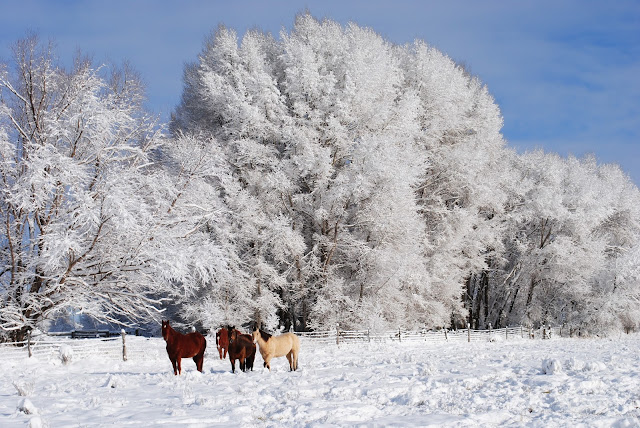In the month of October, Mark had the opportunity to close a
circle that stretched across the Atlantic. Twenty-four years ago when I was
pregnant with Anna, Mark spent six weeks in England on a Rotary Exchange. He
stayed with host families throughout his visit and one home in particular stood
out. This family included a three year old girl, Felicity, who asked her mother
on the way home from picking up Mark, “do
you think he would like to play faum with me?” Of course Mark would. A little set of corrals with animals and a barn reminded him of home.
Skip to 2016, enter Facebook. Mark asked Anna to research
the English family name and sure enough, there was the little girl all grown
up. And she liked horses! Mark issued an invitation to visit the ranch, and Felicity,
with her fiancé Ash in tow, arrived for a visit.
We were in the middle of weaning calves and put them on
horses straightaway. Ash rode Sly, our veteran, and Felicity (Fliss) rode Birdie.
Sly was perfect for Ash, who had only been taking riding lessons for a few
weeks. Birdie, lively and sensitive in nature was a good fit for Fliss and more
like the English version she was used to.
One day we gathered our mountain field. I sent Ash to the
top of a peak where he could see the other side of the property. His job was to
radio down to Fliss and me, riding the creek below him, about cattle hiding out in the
high mountain draws above us. The picture of his silhouette against the skyline
made us realize how far from England they really were.
Later that same day, Fliss decided she didn’t like cows
after all when the few she was following split and each went a different
direction. She would put one in the gate to the corral, then go back for another
one, only to have the one she had just put in come back out again!
They rented a camp trailer and toured Yellowstone and Grand
Teton National Parks in an early snowstorm. They marveled at the Tetons and got
the all-important photos of bison, elk, and even a foraging bear (the same one
that Fliss’s Mom had warned her about!) We took them to Craters of the Moon and
had supper at Pickles in Arco. They soaked at Lava Hot Springs, took part in
family parties and toured the rugged Snake River Canyon at Twin Falls.
I know they learned a lot . . . but then, so did we. We
talked about Brexit (they voted for it) and the fear mongering that went on before
the vote. We talked about vanishing farm ground in England and the consequences
of immigrant influx to their country. We talked about sheep farms in Wales
where Ash grew up, London congestion, the upsides and downsides of universal health care, and what it’s like as young people, working
hard and making their way in the UK.
We had the rare opportunity to see our world through their eyes. When riding in the mountains, Fliss remarked about the “awful brush.”
What? You mean sagebrush? Why, sagebrush is Idaho herself! I told her I didn’t
know anything else. And riding horses to us means walking behind a cow – at a cow’s
pace – in stark contrast to their version, cantering across the English
countryside jumping over hedges! Their version sounds like loads of fun (no wonder they wear helmets) . . .
but we have work to do after all.
Fliss left her recipe of “toad in the hole” on the fridge
before she left. I made it last night and it was almost as good as when she
made it for us. There are several versions of it on the internet. If you try
it, make sure and bake it until the Yorkshire pudding is brown and crispy.
Thanks for visiting our world you two! It was, as the British
say, “lovely.”
 |
| full circle |
 |
Pinning Bedfordshire on the map at the Twin Falls Visitor Center
|
 |
| at ease in a western saddle photo by Anita |












































